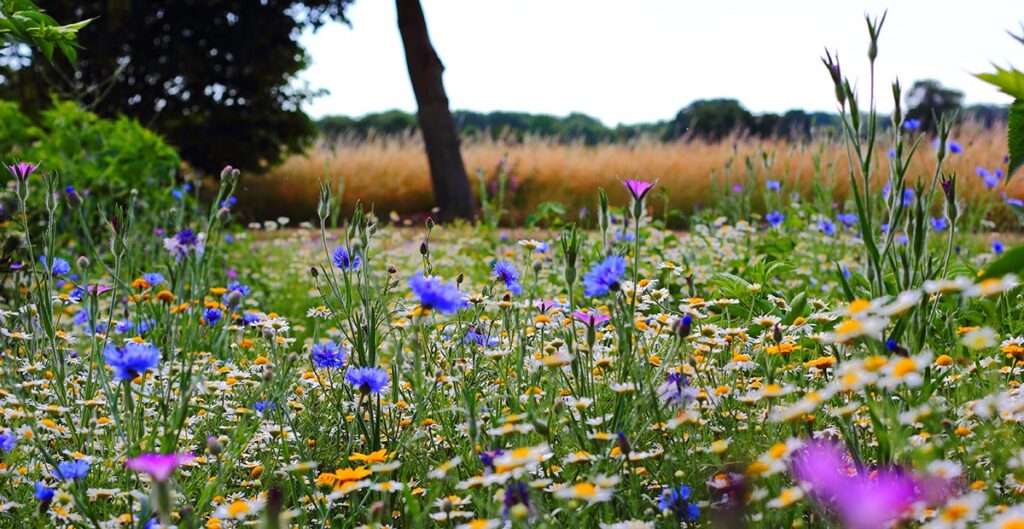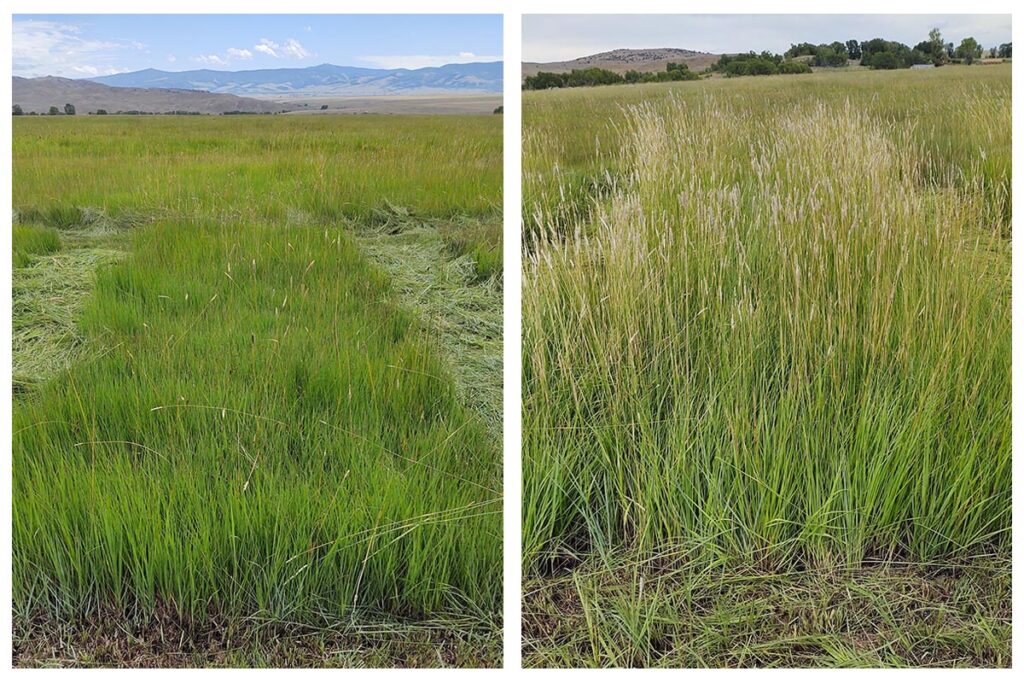By Dr. Joe Brummer and Dr. Jim Ippolito (revised 4/2023)*
Quick Facts…
- Nitrogen can be applied in the fall or spring depending on use of the meadow and goals of the producer, especially concerning grazing.
- Apply nitrogen fertilizers to irrigated mountain meadows based on yield potential. Spring application is usually more effective than fall application.
- Apply phosphate fertilizers based on soil test results. Topdress phosphate fertilizers in the fall which allows time for the P to move into the soil, thereby helping prevent P runoff, reducing water pollution, and improving economics for producers.
- Most Colorado soils contain sufficient available potassium and sulfur for forage production. However, these nutrients may become limiting over time through nutrient removal by hay.
Mountain meadows supply the forage base for year-round livestock production in the Rocky Mountain region. Hay yields from mountain meadows average about 1.3 tons per acre. Low soil fertility is generally the major factor limiting forage production, with nitrogen (N) being the most limiting nutrient.
Use of N fertilizers is generally the fastest, most economical way to increase forage production on irrigated mountain meadows. However, meadows dominated by organic soils that are flooded during part of the growing season may have lower responses to N fertilization than meadows dominated by mineral soils. Therefore, soil type must be considered when determining N management and the profitability of a N fertilization program.
Phosphorus (P) is the second most limiting nutrient for forage production, while potassium (K) and sulfur (S) usually are not limiting. However, these nutrients may become limiting as nutrient removal continues through annual harvesting, especially on highly productive soils. Before establishing a stand, test soils to determine their fertility status so appropriate fertilizers can be applied and properly incorporated.
Do not apply fertilizers immediately adjacent to streams or other surface water to prevent possible water contamination. Applying phosphorus fertilizers in the fall will further reduce the potential for offsite movement of this nutrient and subsequent water contamination as well as reducing economic losses for producers due to lost fertilizer.
Soil Sampling
The value of a soil test in predicting nutrient availability during the growing season is directly related to how well the soil sample collected represents the area sampled. Take samples to a depth of 6 to 8 inches. Many mountain meadow soils contain cobbles and rocks close to the surface that can make sampling difficult. If cobbles and rocks end up mixed with the soil, they should be excluded from the sample before sending to the lab. A good sample is a composite of 15 to 20 soil cores taken from a uniform soil type. Sample areas separately with major differences in soil properties or management practices/histories.
Thoroughly air-dry all samples within 12 hours after sampling by spreading the soil on clean paper or any other clean surface where the soil will not be contaminated. Ship the air-dried soil in a clean sample container to a soil testing laboratory.
Submit an information sheet with as much detailed information as possible for the soil sample(s) being sent to the testing laboratory. This will provide information so fertilizer application suggestions can be tailored to each specific situation. For existing stands, periodically test soils for nutrient analysis for optimum nutrition.
For more information on how to take proper samples, please refer to the Soil Sampling Instructions from the CSU Soil, Water, and Plant-Testing Lab.
Nitrogen Suggestions
Mineral Soils
Forage response to N fertilizer can vary significantly for a number of reasons including fertilizer source, timing and rate of application, and environmental/soil conditions at time of application. Table 1 shows yield responses to various N rates of urea applied in the spring or fall on a mineral soil. Yield increased significantly up to the 150 lbs N/A rate, which is typical for most mountain meadows. In this study, there was little difference in yield response between spring and fall applied urea, but other studies have shown a positive response to spring application. However, spring applications may not be possible for meadows that are very wet in the spring.
Both the recovery of fertilizer N as crude protein in the forage and efficiency of fertilizer N (pounds of additional forage per pound of N fertilizer) tend to decrease at rates above 150 lbs N/A. On mineral soils, recovery of applied N in the forage generally ranges between 30 and 50 percent, but may be as high as 80 percent. Fertilizer N efficiencies for the study in Table 1 ranged between 18 and 36 pounds of additional forage per pound of N applied as urea. These ranges are typical for mineral soils, with the lowest N rates having the highest efficiencies.
Relative effectiveness of various N fertilizer sources is of concern to forage producers. However, rate of N application usually has a greater effect than N source. Granular urea and urea-ammonium nitrate solution (UAN) are the main N sources. Granular ammonium nitrate has a number of positive qualities as a fertilizer source and is still available from a few dealers in Colorado, but purchase is restricted due to the explosive nature of this source.
Research has shown that N losses due to ammonia volatilization from urea-based fertilizers may be of practical significance when the soil pH is greater than 7.0, and when granules lay on a relatively dry soil surface during periods of high air temperatures and windy conditions. Urea Ammonium nitrate has a lower likelihood of N loss via volatilization, as it is a liquid and therefore can move into and interact with soil particles quicker than granular urea. However, surface application of these fertilizers on high-pH soils with significant amounts of plant residues increases the potential for ammonia loss, as plant residues reduce the likelihood for direct soil contact between the urea or urea-ammonium nitrate and the soil.
| Table 1: Effects of nitrogen rates and time of application on yield of irrigated mountain meadow hay located on a mineral soil (3-year averages) (Follett et al., 1995). | ||||
| N rate (as urea), lb/A | Yield, tons/A | |||
|---|---|---|---|---|
| Fall | Spring | |||
| 0 | 1.1 | 1.1 | ||
| 50 | 1.9 | 2.0 | ||
| 100 | 2.6 | 2.6 | ||
| 150 | 2.9 | 2.8 | ||
| 200 | 2.9 | 3.1 | ||
Ammonia volatilization from urea-based fertilizers can be reduced by using products that slow volatilization, at least for a period of time, which gives the N time to move into the soil.
A study was conducted on a mountain hay meadow near Kremmling, Colorado in which Agrotain, Nutrisphere, and Environmentally Smart Nitrogen (ESN) were tested against urea applied at 40 or 80 lbs N/A in both the fall and spring. ESN is a polymer coated, slow-release urea that did not perform well, with yields often lower than urea. Both the Agrotain and Nutrisphere showed promise with yields as much as 25% greater than urea; however, results were variable from year-to-year likely due to differences in N volatilization losses. Yield increases as little as 2 to 3% were not uncommon, which would not offset the additional cost of these products.
Depending on the cost of nitrogen and environmental conditions within a given year, these products may or may not be worth the investment.
Preplant N fertilizers are generally applied broadcast and incorporated in combination with P fertilizers. Nitrogen fertilizers must be applied annually for optimum forage production. Application of N fertilizers to mountain meadows is not suggested under dryland conditions.
Organic Soils
Many mountain meadow soils have developed a dense surface mat of organic matter that ranges from 1 to 4 inches thick. This mat (often referred to as a peat layer) has developed as the result of many years of flood irrigation with cold water from snowmelt. These organic mats contain large amounts of nutrients, the majority of which are not immediately available for plant uptake.
Nitrogen fertilizer applications usually increase forage production on meadow soils with organic mats. However, recovery in the forage and use efficiency of the applied N generally are much lower on organic soils than on mineral soils. Fertilizer N recovery generally averages less than 30 percent on organic soils. Fertilizer N efficiency averages about 20 pounds of additional forage per pound of N at application rates between 60 and 100 lbs N/A. However, lower efficiencies, around 10 pounds of additional forage per pound of N, are not uncommon, depending on individual site characteristics.
Table 2 shows yield responses and fertilizer N efficiencies on a mountain meadow located on a poorly drained and excessively wet organic soil (13 percent organic matter). Forage yields increased from 2.67 to 4.06 tons/A with 180 lbs N/A. Crude protein also increased with N rate. Although yield responses were good at this location, fertilizer N recovery as crude protein in the forage averaged only 18 percent on this organic soil, as compared with 30 to 50 percent on mineral soils.
The waterlogged soil conditions associated with flood irrigation practices common in mountain meadow areas can lead to low fertilizer N use efficiency. The lack of oxygen in waterlogged soils leads to denitrification, which converts various soil N sources into gaseous forms that escape to the atmosphere.
Nitrogen fertilization also can stimulate an increase in microbial activity in these organic soils. This can immobilize considerable amounts of applied N as microbial biomass, which decreases fertilizer N efficiency.
Producer experience indicates that forage yields may actually decline for several years following cessation of a N fertilization program on organic meadow soils. Nitrogen probably is being tied up by soil microbes as the result of the artificially induced imbalance in the soil carbon-to-nitrogen ratio. Based on these observations, once a N fertilization program is initiated on organic soils, it is wise to continue N applications without interruption, if possible. However, the fluctuating and high N prices (~$1.00/lb N) in recent years may make continuous fertilization economically unviable.
Although organic soils respond favorably to N fertilization, the lower rate of N recovery must be considered when determining optimum N rates based on economic returns. Nitrogen fertilization of organic meadow soils generally is economically feasible, but break-even values will be lower compared to mineral soils. Economic increases in forage production generally can be obtained when N is applied to organic soils at rates between 60 and 100 lbs N/A. However, the safest approach for producers with organic soils may be to apply N on small test strips in their meadows, because the variability in response among locations makes it difficult to provide general application recommendations.
| Table 2: Effects of nitrogen rates on yield, fertilizer nitrogen efficiency, crude protein, and fertilizer nitrogen recovery on an irrigated mountain meadow located on an organic soil (Ludwig and Rumburg, 1975). | |||||
| N rate, lb/A | Yield, tons/A | Fertilizer N efficiency, lb forage/lb N | Crude protein | Apparent fertilizer N recovery, % | |
|---|---|---|---|---|---|
| % | lb/A | ||||
| 0 | 2.67 | — | 5.9 | 315 | — |
| 60 | 3.26 | 19.7 | 6.0 | 391 | 18.5 |
| 120 | 3.71 | 17.3 | 6.3 | 467 | 20.2 |
| 180 | 4.06 | 15.4 | 6.5 | 528 | 19.0 |
| 240 | 3.84 | 9.8 | 7.1 | 545 | 15.0 |
Special Nitrogen Management Considerations
Fall applications of N fertilizers can produce hay yields equal to or greater than spring applications, depending on species present and if appropriate application timing is used. Research shows that meadows, especially those with a high proportion of smooth bromegrass, can produce higher hay yields if fertilized in the fall. Applying N in the fall stimulates smooth bromegrass plants to set more reproductive tillers which translates to higher yields the following summer.
One must keep in mind that, although higher yields are possible, quality (crude protein content and digestibility) of that forage may be lower due to the higher fiber content of reproductive grass tillers.
Timing of fall N applications is also an important consideration to achieve the maximum benefit of the fertilizer, regardless of the grass species present in the meadow. Applying N too early in the fall allows grass plants time to take up some of the N and translocate it into aboveground tissues. This N is then tied up in the litter component when the plant eventually goes dormant in the fall, making N unavailable for growth in the spring. Ideally, N fertilizers should be applied to mountain meadows early enough in the fall to allow uptake by the roots, but late enough so the N does not get translocated into the aboveground leaves of the plant. For most high elevation meadows, fall application of N fertilizers should take place after the first of October, and before the ground freezes, for maximum efficiency.
A final consideration of whether to apply N fertilizers in the fall or the spring concerns the grazing practices on a given meadow. If the meadow will be grazed in the spring and the ultimate goal is hay production later in the season, then the meadow should not be fertilized in the fall. Grass plants are essentially sponges for N and they will quickly take up any available N in the spring that was applied in the fall and translocate it into aboveground leaves. As animals graze the leaves off in the spring, they remove significant amounts of the applied N thereby reducing fertilizer efficiencies and subsequent hay yields later in the summer. Similarly, N fertilizers should not be applied too early in the spring if the meadow will be grazed.
Given adequate moisture, it takes as little as 10 to 14 days for a considerable amount of spring-applied N to be translocated into the leaves where it can be grazed off by livestock. On the other hand, if the goal is to produce forage for spring grazing, then fall or early spring applications of N can be used as tools to increase forage yields.
Phosphorus Suggestions
Forage responses to applied P are most likely on soils with low or medium levels of extractable P. Suggested P rates (Table 3) are based on broadcast applications related to soil test levels. The main soil tests for extractable P in Colorado soils are the AB-DTPA and sodium bicarbonate (NaHCO3) tests, and values for both tests are included.
Table 3 suggests P rates for establishing irrigated meadows for forage production. Take soil samples prior to seedling establishment. Broadcast and incorporate phosphate fertilizers into the soil prior to seeding.
Established meadows should be topdressed periodically with P fertilizers to help maintain stands, especially if legumes are present. For established stands, apply P fertilizers on the basis of soil test P concentrations, but use about half of the rates suggested for new seedings. Test soils in the early fall so P fertilizers may be topdressed in the fall, if needed. While P moves slowly in soil under most conditions, phosphate fertilizers may be washed into cracks in dry soil during the fall and spring, or be incorporated by freezing and thawing during the winter months. Branch roots near the soil surface also may absorb applied fertilizer P.
Because P is not often susceptible to leaching losses, it can be applied once every two to three years at higher rates to avoid yearly application costs. The probability of forage response to topdressed P is greater on soils testing very low to low in extractable P.
Placement of P fertilizers in the root zone is important because P is not mobile in soil. Broadcast application followed by incorporation prior to new stand planting is the most efficient placement method for P.
Most phosphate fertilizers are equally effective per unit of P. Choose a fertilizer based on availability and cost per unit of P.
| Table 3: Suggested broadcast phosphorus rates for irrigated mountain meadows. | ||||
| ppm P in soil | Relative level | Fertilizer rate, lb P2O5/A | ||
|---|---|---|---|---|
| AB-DTPA | NaHCO3 | New seedings | Established stands | |
| 0 – 3 | 0 – 6 | very low | 80 | 40 |
| 4 – 7 | 7 – 14 | low | 40 | 20 |
| 8 – 11 | 15 – 22 | medium | 20 | 10 |
| > 11 | > 22 | high | 0 | 0 |
| NOTE: Apply P fertilizers for established stands on the basis of new soil test results. | ||||
Potassium Suggestions
Most Colorado soils contain relatively high extractable K. Table 4 suggests revised broadcast K fertilizer rates for irrigated mountain meadows. Past data suggested that, in order to determine a K fertilizer recommendation, the relative concentration of K in soils should range from 0 – 60 (low), 60 – 120 (medium), and > 120 (high). However, two relatively recent studies suggest that these ranges might need to be adjusted downward, likely due to a number of soil factors in Colorado mountain meadows (e.g., mineralogy, organic materials containing potassium, soil sample collection/timing, etc.)
| Table 4: Suggested broadcast potassium rates for irrigated mountain meadows (Revised 2023). | ||
| ppm K in soil AB-DTPA or NH4OAc | Relative level | Fertilizer rate, lbs K2O/A |
|---|---|---|
| 0 – 40 | low | 60 |
| 40 – 80 | medium | 40 |
| > 80 | high | 0 |
From 2019 to 2021, a K and P fertilizer trial was conducted on an irrigated meadow at the CSU Beef Improvement Center near Saratoga, Wyoming. Over the study, background soil extractable K (NH4OAc) and P (AB-DTPA) concentrations ranged between 60 to 80 ppm and 4 to 5 ppm, respectively. Treatments included an unfertilized control and all combinations of 0, 40, and 80 lbs K/A and 0 and 80 lbs P/A applied one time in the fall of 2019 (Table 5).
Yield and soil samples were collected in late July 2020 and 2021. A significant yield increase was observed in all plots receiving P fertilizer; however, no response to K fertilization was observed over the study (Figure 1, Table 5). The plant response due to P fertilizer application was not surprising, as this location required P additions based on the fertilizer recommendations within this document. Surprisingly, no plant response to K fertilizer application was observed, leading us to question whether K was being supplied by decaying organic matter or minerals present in the soil that simply are not accounted for via the NH4OAc extraction. Regardless, these results lead us to question the validity of, and thus alter the K fertilizer recommendations for mountain meadows in Colorado.
Figure 1. Plots that had either received only potassium (left) or phosphorus (right) fertilizers, both applied at 80 lbs/A in fall 2019. There was no difference in yield or visual appearance between the control (0K, 0P) and potassium only plots. Photos were taken in July 2020 (Joe Brummer).
The above finding is further supported by results from near Fruita, Colorado where 0, 50, 100, and 150 lbs/A of K fertilizer was applied for 3 consecutive years to a soil measuring between 80 and 100 ppm of extractable K. Alfalfa was raised over the 3-year study. Only minor and inconsistent yield increases were observed, which were not enough to even cover the cost of the fertilizer. Alfalfa has a higher K requirement compared to grasses, and similar cutoff ranges as those cited in the first paragraph of this section are typically used to decide on the need for K fertilization. If plants were going to respond to added K based on the measured soil K levels in the medium range, then alfalfa should have responded in this Fruita, Colorado study due to its higher requirement. Therefore, based on findings from these two studies, we have revised the recommended ranges downward to those presented in Table 4.
If K additions are deemed necessary based on the revised ranges, then the main K fertilizer is KCl, or potash. Broadcasting or incorporating K into the soil prior to planting can both be equally effective in terms of delivering K to future mountain meadow plants. Established stands can benefit from K fertilizers being top-dressed. If K is required, top-dressing will help maintain stands, and this is especially true if legumes are present.
| Table 5: Forage yields in 2020 and 2021 following a one-time application of various rates of potassium (K) and Phosphorous (P) fertilizer applied in 2019. The study was conducted on a mountain meadow dominated by common meadow foxtail at the CSU Beef Improvement Center near Saratoga, WY. | |||
| Potassium rate, lbs/A | Phosphorous rate, lbs/A | Yield 2020 (lbs/A) | Yield 2021 (lbs/A) |
|---|---|---|---|
| 0 | 0 | 3277 | 1126 |
| 40 | 0 | 3163 | 1243 |
| 80 | 0 | 2950 | 1033 |
| 0 | 80 | 5288 | 1553 |
| 40 | 80 | 5366 | 1662 |
| 80 | 80 | 5081 | 1603 |
Sulfur Suggestions
Sulfur is a key component of protein, and demand for S increases as forage yields increase. Adequate S is required for optimum N-use efficiency, so S nutrition should not be overlooked in forage management. Poor S nutrition can lead to low plant protein content and digestibility in forages. Several fertilizer sources are available to supplement S needs of crops.
Most Colorado soils contain adequate levels of available S, and soil tests for available S are not routinely performed. Irrigation water from most surface waters and some wells often contains appreciable SO4-S, so irrigated soils are usually adequately supplied with S. However, some well waters are low in SO4-S, so water samples should be analyzed if soils are low in organic matter and S deficiency is suspected.
Other Nutrients
There have been no confirmed deficiencies of boron (B), copper (Cu), iron (Fe), manganese (Mn) and zinc (Zn) in mountain meadows for forage production in Colorado.
Literature Cited
Follett, R.H., D.G. Westfall, J.F. Shanahan, and D.W. Lybecker. 1995. Nitrogen fertilization of mountain meadows. J. Prod. Agric. 8:239-243.
Ludwick, A.E., and C.E. Rumburg. 1975. Nitrogen sources and rates for meadow hay production. Colorado State Univ. Exp. Stn. Prog. Rep. PR 75-33.
*J.E. Brummer, Colorado State University Extension forage specialist and associate professor; J.A. Ippolito, Extension soil fertility specialist and professor; Soil and Crop Sciences. Originally authored by J. Mortvedt, Colorado State University Extension soil specialist; and D.H. Smith, professor; Soil and Crop Sciences; and then revised by J.E. Brummer and J.G. Davis, Soil and Crop Sciences. 3/96. Revised 4/23.
Go to top of this page.











